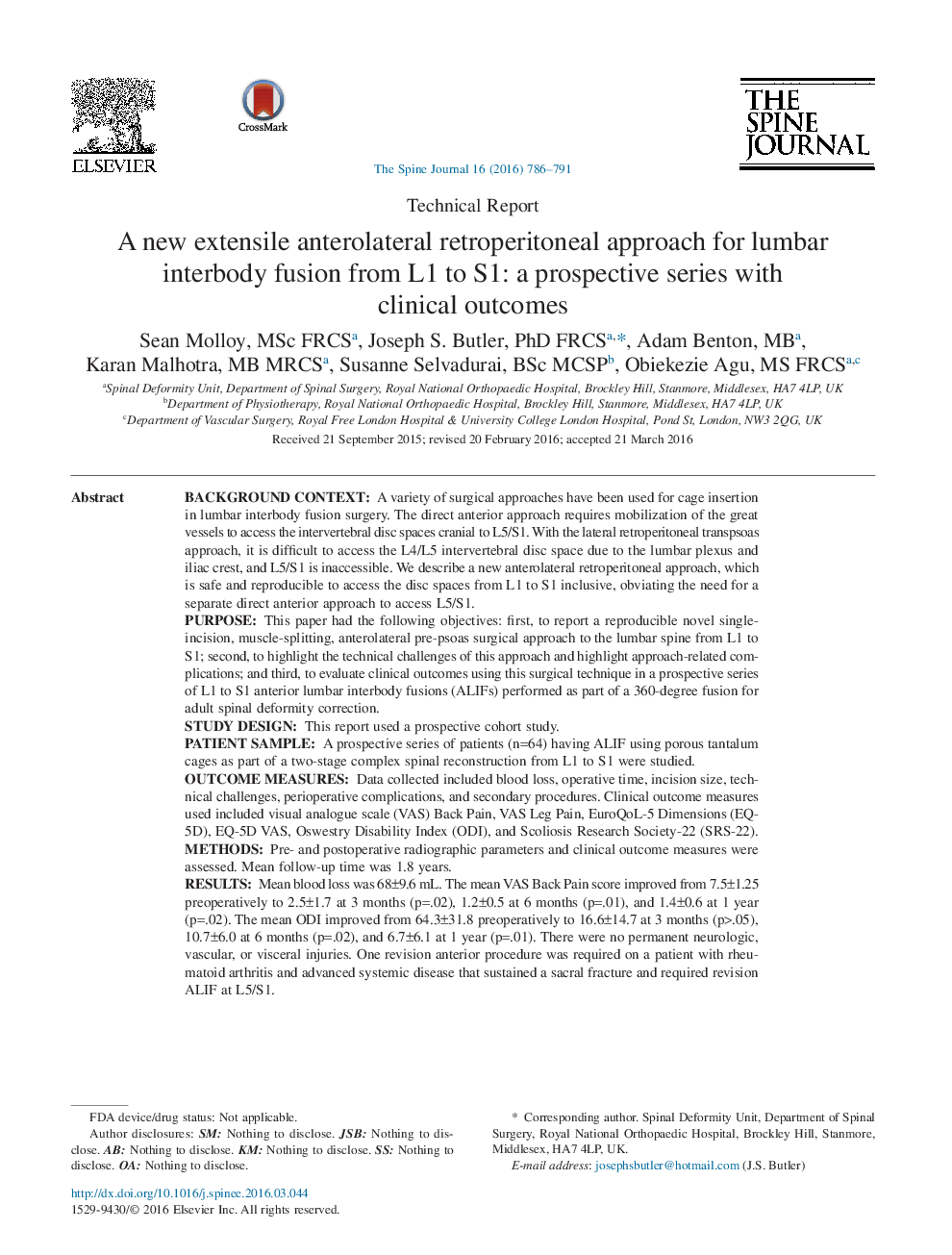| کد مقاله | کد نشریه | سال انتشار | مقاله انگلیسی | نسخه تمام متن |
|---|---|---|---|---|
| 4095970 | 1268549 | 2016 | 6 صفحه PDF | دانلود رایگان |

Background ContextA variety of surgical approaches have been used for cage insertion in lumbar interbody fusion surgery. The direct anterior approach requires mobilization of the great vessels to access the intervertebral disc spaces cranial to L5/S1. With the lateral retroperitoneal transpsoas approach, it is difficult to access the L4/L5 intervertebral disc space due to the lumbar plexus and iliac crest, and L5/S1 is inaccessible. We describe a new anterolateral retroperitoneal approach, which is safe and reproducible to access the disc spaces from L1 to S1 inclusive, obviating the need for a separate direct anterior approach to access L5/S1.PurposeThis paper had the following objectives: first, to report a reproducible novel single-incision, muscle-splitting, anterolateral pre-psoas surgical approach to the lumbar spine from L1 to S1; second, to highlight the technical challenges of this approach and highlight approach-related complications; and third, to evaluate clinical outcomes using this surgical technique in a prospective series of L1 to S1 anterior lumbar interbody fusions (ALIFs) performed as part of a 360-degree fusion for adult spinal deformity correction.Study DesignThis report used a prospective cohort study.Patient SampleA prospective series of patients (n=64) having ALIF using porous tantalum cages as part of a two-stage complex spinal reconstruction from L1 to S1 were studied.Outcome MeasuresData collected included blood loss, operative time, incision size, technical challenges, perioperative complications, and secondary procedures. Clinical outcome measures used included visual analogue scale (VAS) Back Pain, VAS Leg Pain, EuroQoL-5 Dimensions (EQ-5D), EQ-5D VAS, Oswestry Disability Index (ODI), and Scoliosis Research Society-22 (SRS-22).MethodsPre- and postoperative radiographic parameters and clinical outcome measures were assessed. Mean follow-up time was 1.8 years.ResultsMean blood loss was 68±9.6 mL. The mean VAS Back Pain score improved from 7.5±1.25 preoperatively to 2.5±1.7 at 3 months (p=.02), 1.2±0.5 at 6 months (p=.01), and 1.4±0.6 at 1 year (p=.02). The mean ODI improved from 64.3±31.8 preoperatively to 16.6±14.7 at 3 months (p>.05), 10.7±6.0 at 6 months (p=.02), and 6.7±6.1 at 1 year (p=.01). There were no permanent neurologic, vascular, or visceral injuries. One revision anterior procedure was required on a patient with rheumatoid arthritis and advanced systemic disease that sustained a sacral fracture and required revision ALIF at L5/S1.ConclusionsThe technique described is a safe, new, muscle-splitting, psoas-preserving, one-incision approach to provide access from L1 to S1 for multilevel anterior or oblique lumbar interbody fusion surgery.
Journal: The Spine Journal - Volume 16, Issue 6, June 2016, Pages 786–791